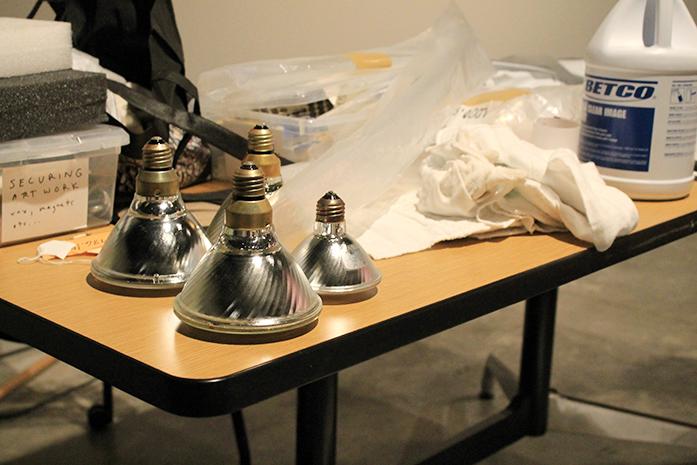Faded, seemingly tarnished bronze, the foot-and-a-half tall man stands with feet apart, the blunt ends of nails protruding from his wide chest, arms, and back, a few dotting the tops of his legs. One empty hand is raised in the air.
Though quite different in meaning, the Nkisi Nkondi figure from the Kongo could easily fit visually as a symbol of the modern “Hands Up, Don’t Shoot” movement.
It rests now in the IMU Black Box Theater, part of the UI Museum of Art Social (In)Justice gallery, opening Saturday as part of the university’s Just Living semester theme.
“We didn’t want to offer any solutions; we just wanted to give people something to consider,” said lead curator Dale Fisher. “I don’t have answers, but I know racism isn’t over because we have a black president. Even though we know there are women artists, it’s not 50-50 in the art world as it is in the real world.”
The gallery, painted a subdued, pale gray, is separated into four sections, each looking at an idea in social justice: “The Path of Power,” “America, The Other … ,” “The American Feminist Art Movement,” and “Just Living in the Midwest: Grant Wood at 125.”
“The topics actually bled into one another,” Fisher said. He curated “America, The Other … ,” which looks at people left out of the big narrative of American history — minorities, underprivileged individuals, members of the LGBT community. Pieces from the African section could have been included in his area, because there was certainly marginalization there; the same applies to the feminist pieces.

Each area has a title wall, painted in that curator’s chosen color, breaking up the monotone grayness. The feminist artwork has a pink wall; the underrepresented section a black one with white text.
“Even though there aren’t clear lines of division, you get the idea you’re stepping into a new section, a new moment,” Fisher said.
On one side of the pink wall rests a framed image of Earth nestled in a starry sky, a radiant red bomb headed straight for it, an “estrogen bomb.” Near the bottom it reads, “Send estrogen pills to presidents, prime ministers, generals, oligarchs, and CEOs everywhere.”
“[Feminists] believed that art was not merely an object for aesthetic admiration but could also encourage viewers to question the social, political, and cultural landscape and through this questioning, possibly affect the world and motivate change toward equality,” said Kathleen Edwards, a museum curator who worked on the feminist section, in a show label.
On the other side of the wall are images from Grant Wood. The central image, “Daughters of Revolution” seems delicate, a dulled charcoal image on brown paper of three women resting in a wide, short frame.
Wood’s area fades into “America, The Other … ,” meeting an image from Ho Che Anderson’s biographic graphic novel on Martin Luther King Jr. The panels, in black and white, show King in moments from the 1960s.
“If you didn’t read about it and know it was from the ’50s and ’60s Civil Rights Movement, it could absolutely be contemporary with the Black Lives Matter movement,” Fisher said.
Drifting right, closest to the entrance, the space is overtaken by African art, broken into three main components: sovereignty, law, and authority; status, rank, and prestige; norms, ideals, and outcasts.

Wooden masks and beaded caps take up much of the display. On the leftmost side of one shelf sits a Yoruba chief’s headdress made entirely of faded fiery red beads, the color a tribute to Shengo, the god of thunder.
“The form appropriates a British magistrate’s wig,” said Cory Gundlach, curator for “The Path of Power.” “It is a combination of British colonial and Yoruba symbols of power.”
In the center of the exhibit is a Boli figure from the Bamana people, somewhat resembling a large, pot-bellied mass on four legs, in an earthy brown.
“As a model of the cosmos, it is used to enforce and validate law in Bamana society,” Gundlach said. “In terms of African art objects that support social justice, it is perhaps the strongest example in the exhibition.”
Two small figures share a metal base on an adjacent shelf, sitting maybe 5 inches apart, a chain connecting the tops of their heads, sloping down, suspended between their bodies. Meant to represent a partnership? Or the shared bond of suffering?
“We argue in the museum all the time about whether we’re speaking on other people’s behalf,” Fisher said. “No one in this gallery is doing that. For us, we’re using artists’ work to support our own ideas, to tell a version of the story.”
The story is already out in the world, particularly given the research done on many of the featured works, the acclaim and criticism they’ve gathered.
“I would just like people to leave questioning the idea of where people are in society; there are societal constructs put there,” Fisher said. “It’s not the case that there is total equality anywhere.”
Recognizing it does not yet exist is the first step toward bringing it to life. Social justice now is more a goal than a reality, Fisher said.



